Editor’s note 12/5/18: We originally rated Just Cause 4 a 7/10. However, after a few more hours of play, sleeping on it, and deciding that “fun” just couldn’t salvage the game from some of the more glaring issues put forth in this review, we have decided to push the overall score to a 6/10. The original review follows.
Since its announcement, Square Enix has put a lot of effort into making us believe that Just Cause 4 sits at the pinnacle of open-world, sandbox action games. Words like “groundbreaking” and phrases like “best in class” have been used to describe its gameplay and redesigned engine in ads and dev diaries from the start.
It’s true that it’s a step forward in a series predicated on schticky storylines, explosive combat, and glorious B-movie action. But on the other side of the coin, it’s a sideways step that keeps the franchise from realizing the mammoth potential in Avalanche’s new Apex engine.
Regrettably, it appears someone didn’t look up the definition of groundbreaking before slapping it on the game’s marketing materials; and while “best in class” isn’t a complete misnomer, it does belie the true nature of what the game’s new engine can achieve.
That’s all to say that this game could be more.
However, that’s not to say Just Cause 4 is a bad game. It’s also not to say Just Cause 4 is a boring game. In fact, it’s quite a good game, and it’s quite a fun game, especially by the standards already set by the series itself. It’s simply not what one would call “groundbreaking.”
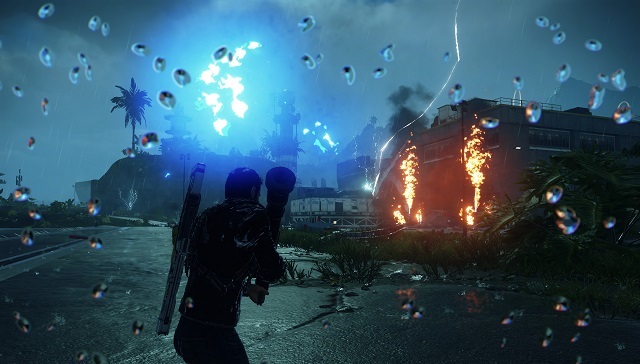
If you’re familiar with the overall franchise, JC4’s conceit is a recognizable one. Once again, revolutionary-for-hire Rico Rodriguez is out to dispose of a dastardly dictator who is, once again, subjugating a remote island nation under an iron fist and a couple of billion soldiers. Of course, said dictator also has aspirations of world domination (don’t they all?) and one nasty WMD to prove it.
In this case, the appropriately over-the-top agent of destruction is Project Illapa, a weapon that controls Solis’ weather. Illapa generates destructive storms at will, ranging from tornadoes to sandstorms to blizzards. It reeks of Bond film McGuffin, but it’s a plot device true to the hyperbolic nature of the series, and one that moves the overarching story forward if you’ve been following along from the start of the series.
Although mostly well-written in an action-movie sort of way and at times, somewhat stimulating, the story in Just Cause 4 will (unsurprisingly) win few awards for originality or narrative resonance — even though it tries harder to do so than previous installments.
In what might be one of its glaring faults, Just Cause 4 doesn’t embrace its own quirky nature, instead opting for a more serious tone that bullies Rico’s quips and fourth-wall camera winks into the dark corner on the other side of the room.
Whereas Just Cause 3 had Mario Frigo and Just Cause 2 had Baby Panay, Just Cause 4 has no one to lighten the mood and bridge the gap between the tone found in the story and the one found in its gameplay.
Fortunately, we’re not here for the story. Instead, we’re here to blow shit up, something Just Cause 4 does very well.
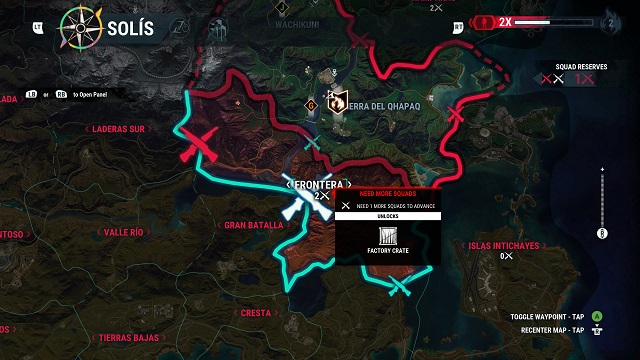
From the game’s opening moments, it’s clear the island nation of Solis has been irreparably shaped by The Black Hand, its leader, and Project Illapa. As a career despot-deposer, it’s Rico’s job to aid the island’s insurrectionists in their quest for freedom.
Wresting control of the game’s regions is a little different this time around, though. Whereas Chaos still plays a large role in subduing areas of the map, Just Cause 4 introduces a new Frontline system that adds a bit of strategy and complexity to the mix, even if the enemy never pushes back or retakes territory once you’ve attained it.
When you first start out, you immediately have access to the entire map. However, venturing outside of the small area initially controlled by the rebellion will be difficult since The Black Hand has an overwhelming presence in outlying regions.
As you blow up structures and Black Hand vehicles, you get Chaos points, which vary in value based on the size and power of the structure or vehicle destroyed. The bigger the structure or more powerful the vehicle, the more Chaos points you get.
After you’ve collected enough points and leveled up your Chaos meter, you’re rewarded with squads, groups of freshly recruited rebels. You don’t control these squads outright, but instead use them to annex territory via the Frontline system, which is akin to the hex-based annexation system found in strategy games like Civilization and Endless Legend just with less strategy and no one fighting back.
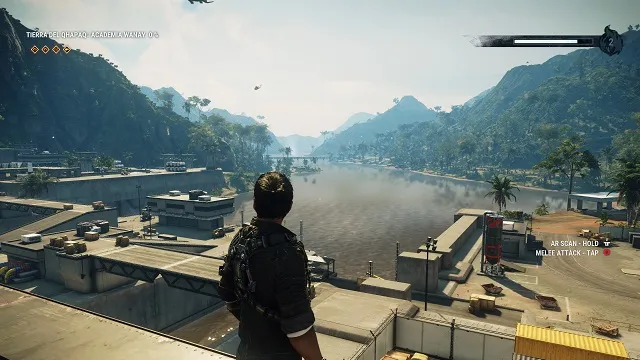
To acquire a new region, you need to have a Frontline touching the region and enough squads to take it over. But that’s after you’ve completed the Region Strike within the area you want to take over.
Region Strikes are essentially mandatory side missions — completing them is a requirement to take over regions and progress in the game, but they aren’t story missions in and of themselves. They are always centered around a large, well-defended Black Hand facility, and most objectives involve freeing rebels, sabotaging Black Hand equipment, stealing some type of intel, or defending some important object.
These missions could simply be labeled “Find Terminals and Defend” since most of the gameplay falls into the rote repetition of “find, enable, defend, find …” over and over again.
After you’ve completed one Region Strike in an area, established a Frontline in an adjacent area, and caused enough Chaos to get the squads you need, you can annex it and push back the Black Hand to make exploration easier and stunts less hectic.
Bringing more regions under the influence of the rebellion not only extends the friendly play area, but it also gives you goodies like new weapons and vehicles. Some areas even provide stackable buffs that decrease your supply drop cooldown, meaning one or all of the game’s seven unlockable pilots can continually send guns and ammunition your way, ramping up the mayhem and chaos.
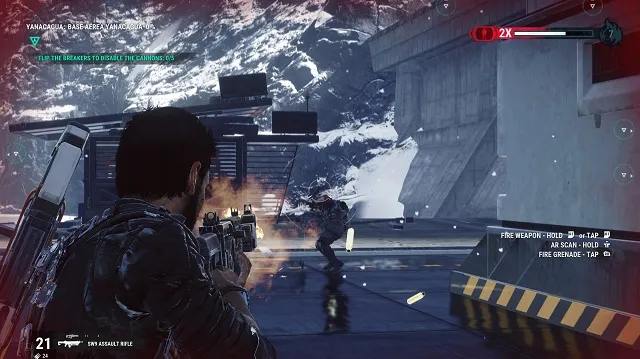
On a very basic level, primary guns like assault rifles, submachine guns, and rifles are mostly interchangeable in many situations. I never found myself actively seeking out a specific weapon in my 19 hours with the game because traversing from one point to another with the grappling hook is so fluid. Switching from an assault rifle to a sniper rifle just isn’t as economical as quickly grappling to the top of a tower and pulling the trigger on a camping sniper.
Rocket launchers and grenade launchers are still powerful and useful in their own right, even if they’re still unreliable against moving targets or targets you want to kill right away (I’m looking at you, grenade launcher). New weapons like the lightning gun and wind gun might be niche, but they’re a hell of a lot of fun to play with and add memorable variety that the other guns don’t necessarily provide.
The biggest change to the game’s weapons, however, comes in the form of secondary fire, which makes up for the dip in the number of weapons available in the game (down to 19 in JC4 from 30 in JC3). While every weapon doesn’t have a unique auxiliary fire, there are enough options to go around that help you remember to switch things up.
For example, the SMG fires small tactical missiles while one assault rifle can launch grenades and another can spawn free-roaming drones that attack enemies on site. The lightning gun’s secondary might be the most dynamic, though, in that it ionizes the air and creates a lightning storm in the nearby area.
Gone from Just Cause 3 are pistols and revolvers, throwables like grenades, and dual-wielding. None of these are terribly missed, though, as the game’s other weapons and items more than make up for their absence.
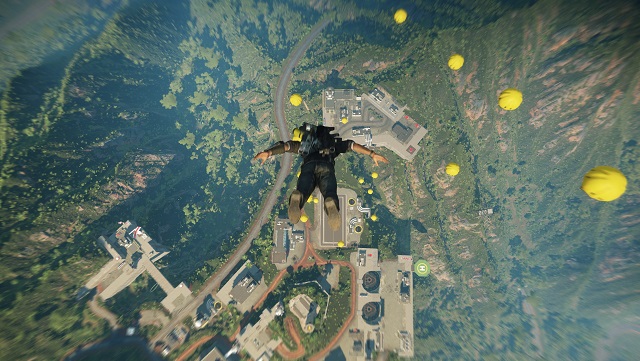
The star of the show is the grappling hook. Just Cause wouldn’t be Just Cause without it, and with all of the changes made to JC4, it’s good to see that the grappling hook we all know and love remains mostly the same.
You can use it to catapult yourself into the air, climb towers (or mountains) in a single bound, and Scorpion yourself over to an enemy for a swift kick in the chest. Getting from one side of a base to another is often fastest using the grappling hook. Why drive or fly when you can zip?
But the most interesting part about the grappling hook is that the (very) light upgrade system found in Just Cause 3 has gotten a relatively detailed makeover for the sequel. Now, instead of going to a single character for upgrades based on story missions, you’re able to upgrade your grappling hook by completing stunts, challenges, and side quests from three unlockable NPCs, each of which provides a specific upgrade tree with unique mods.
For example, one tree allows you to tether balloons to any object or person, sending them floating off into the stratosphere; another mod tree allows you to attach booster rockets to anything, sending person or object zipping off in a swoosh or spinning uncontrollably like a death-dealing dervish; and another mod tree allows you to pull two objects together with explosive force or open doors that weigh several tons.
Smartly, Just Cause 4 doesn’t wait too long to give you access to the base mods for all three tether types as all three NPCs have available missions almost at the start.
As you complete missions for these NPCs, you’ll get points specific to each of them. Finish enough missions, complete enough challenges, or perform enough stunts, and you’ll unlock further modifications that allow further customization, such as increased launch force, situational tether strength, and directional rocketing.
The customization options are vast and granular, opening up new and creative ways for patient and inventive players to come up with some truly zany combinations. Even if you’ll probably never use more than the base mods in most situations, it’s nice to have customizable options that allow for hours of tangential, creative rabbit-holing.
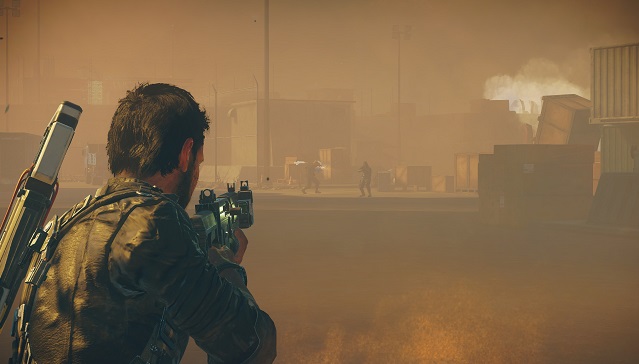
Perhaps the biggest disappointment in Just Cause 4 is the vaunted weather system. Built up to be the game’s golden calf, it’s simply a letdown.
I admit that I went into the game thinking the new Apex engine would allow dynamic storms to influence locales and combat on a fluid, any-second-now basis. Based on the hype around the game — and what’s been shown off before release by Avalanche and Square Enix — I’d bet I’m not the only one with those not-so-lofty hopes and expectations.
Unfortunately, weather is mostly relegated to set pieces. And while those set pieces can be awesome examples of what Apex can do, they don’t much impact the world of Just Cause 4 on a moment-to-moment basis.
As you progress through the story and gain control of a few Black Hand weather facilities, you can summon storms at any moment — but only in that immediate region and only if you trek up to the lone terminal in the middle of the far-away facility and activate it.
When storms do show up in-game (which I only ran into two storms I could call “organic” in 19 hours), they’re more aggravating than they are cool. Dodging hundreds of bullets and lightning at the same time turns everything up to 11 in the most frustrating ways possible. Trying to see through dense clouds of sand while a hundred dead-eye soldiers fill you full of lead deflates the power fantasy you’ve worked so hard to create.
Something that was meant to make Just Cause 4 off-the-rails insane is instead relegated to the mundanity of “Mission XYZ”. I suppose random storms could be irritating in their own right, but the magic Avalanche had in mind is completely lost when in your control or stuck in only one corner of the world.
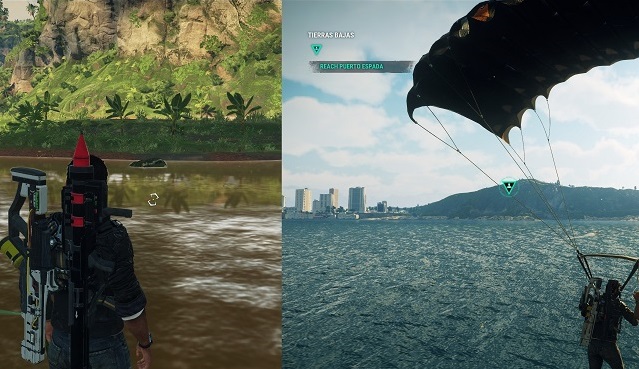
To this point, I haven’t mentioned the game’s graphics at all. That’s because, like its weather system, JC4‘s graphics are sometimes disappointing and wildly inconsistent. Although Square acknowledged that the potato-tier cutscenes in the early review build would be fixed upon release, they didn’t mention anything about erratic performance in regards to water, shadows, and level of detail.
Speaking with several colleagues, I found I wasn’t the only one experiencing less-than-stellar optics on both PC and console. Although there may be an incoming patch that will fix these issues, they are worth mention in the meantime.
I’m running the game on a pretty beefy rig (i7-7700k, GTX 1080 8GB, and 32 GB RAM); that’s above the recommended requirements on the game’s Steam page. However, water still looks splotchy and muddy in places, shadows rip and move unpredictably in almost every occurrence, and the overall level of detail unreliably shifts based on locale and region.
For example, the water in the opening jungle area looks like nothing more than an uncomfortably undulating sea of mud — there’s very little form to it and from certain angles, individual pixels can be seen from some distance. However, along the coast, things are considerably better, with water looking particularly crisp and colorful as it transitions out of shallows to deep water and back.
But even then, there are areas that look as if they’re covered with a worn blue tarp, devoid of any real detail other than “I know that’s water because coast.”
It also took some tweaking to get shadows looking just… OK. While the jagged shadows of overhanging trees are troublesome, things become overly bothersome with the unnatural shadows on Rico’s character model, as well as the splotchy shadows created from smoke, explosions, aircraft, and more.
For a game that’s historically pretty darn beautiful, it’s disappointing to see that the PC version is poorly optimized from the start. If Avalanche releases a patch that fixes these issues, I’ll amend this part of the review to reflect such a course correction.
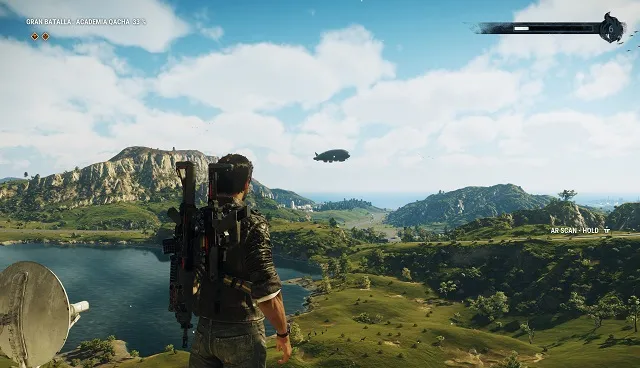
Pros:
- Solid mechanics and controls
- Increased tether customizability
- Frontline adds depth to territory acquisition
- Explosions, glorious explosions
Cons:
- Weather system doesn’t live up to hype
- Inconsistent graphics on both console and PC
- Larger shift toward serious storytelling
- Irritatingly repetitive missions
Your main takeaway should be this: Just Cause 4 is a fun game and worth your attention if you’re a fan of the series. In many ways, this could be called Just Cause 3.5, as it exhibits many of that game’s best qualities.
Unfortunately, a poorly executed weather system, inconsistent graphics plagued by pop-in, and a story that takes itself too seriously keep Rico’s latest adventure from achieving its full potential.
[Note: The developer provided the copy of Just Cause 4 used in this review.]







Published: Dec 4, 2018 12:32 pm